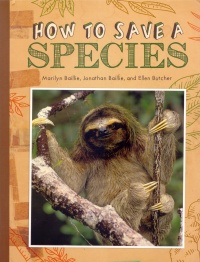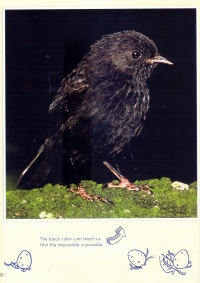| ________________
CM . . .
. Volume XXI Number 10 . . . . November 7, 2014
excerpt:
Each species presented in the book is profiled with descriptive features, a brief history of its decline, what has been done so far, and the results. These facts are also noted in summary form on the same page. In several cases, a short ‘Meet the Scientist” note introduces someone at the forefront of work and shares that person’s thoughts. Because the book only covers 17 specific species, double-page spreads at the back offer a map showing where the 100 most endangered species are found, as well as their remaining numbers (disturbingly, many are listed as ‘numbers unknown’). The Contents page is color-coded and linked to the location of the appropriate chapter by colored tabs along the open edge of the book, as well as by page number. This seems a bit superfluous and wasn’t really obvious at first, although it provides a bit more visual appeal. A Glossary and Index complete the book. Close-up photos are excellent, even for those species that are quite unusual and seldom seen. For example, the Saola, an antelope-like mammal living in the dense forests of Vietnam-Laos, incredibly has not been seen in the wild by scientists. The only available photos have come from motion cameras attached to trees that snapped pictures at night. Some guesswork is involved regarding remaining numbers of this animal, and the best conservation plan may be to protect its habitat. So why the push to save such an elusive animal? The scientist involved in this effort comments that its “combination of beauty and mystery is something very special. The world would be a poorer, duller place without the saola.” Therein lies the essence of this book— to remind us about the links between all living things, however small or little known, and how minimal conservationist actions, even on the local level, can contribute to helping all wildlife and thus preserve biodiversity. While the information on each species is brief, it serves as an adequate introduction that will inspire readers to seek further details on their own. The map, ‘Where on Earth?’ is fascinating as it allows a reader to see species both local (interesting for the few North American examples) and exotic (intriguing to see the concentrations in other parts of the world). These details are keys that can open doors to further learning and to stimulate interest in the conservation movement. This slim volume will appeal to all reading levels for its lively, informative presentation that will make younger generations aware of such a significant topic. Highly Recommended. Gillian Richardson is a freelance writer living in BC.
To comment on this title or this review, send mail to cm@umanitoba.ca.
Copyright © the Manitoba Library Association. Reproduction for personal use is permitted only if this copyright notice is maintained. Any
other reproduction is prohibited without permission.
CM Home | Next Review | (Table of Contents for This Issue - November 7, 2014.) | Back Issues | Search | CM Archive | Profiles Archive |

 Among many books for young readers about endangered species, this co-authored text places the focus squarely on the work already undertaken or on urgent plans to save 17 particular animals and plants from extinction. With notable successes, such as the recovery of humpback whales and black robins, scientists are hopeful they can use similar tactics in their efforts to save many more critically endangered species such as Javan rhinos, Cebu Frill-wings, and Attenborough’s Pitcher Plant. The author details how the work proceeds with research in the field to find out where the target species lives, how many are left, and the reasons for their decline. Then plans are tailored for each species’ situation and will involve local communities, governments and wildlife organizations. The authors worked with the International Union for the Conservation of Nature and Zoological Society of London to obtain current estimated numbers for endangered species.
Among many books for young readers about endangered species, this co-authored text places the focus squarely on the work already undertaken or on urgent plans to save 17 particular animals and plants from extinction. With notable successes, such as the recovery of humpback whales and black robins, scientists are hopeful they can use similar tactics in their efforts to save many more critically endangered species such as Javan rhinos, Cebu Frill-wings, and Attenborough’s Pitcher Plant. The author details how the work proceeds with research in the field to find out where the target species lives, how many are left, and the reasons for their decline. Then plans are tailored for each species’ situation and will involve local communities, governments and wildlife organizations. The authors worked with the International Union for the Conservation of Nature and Zoological Society of London to obtain current estimated numbers for endangered species.